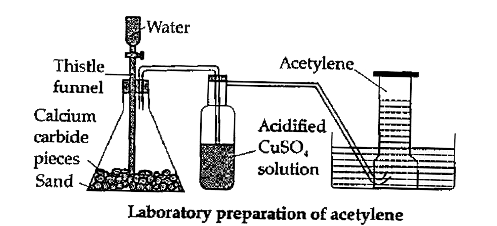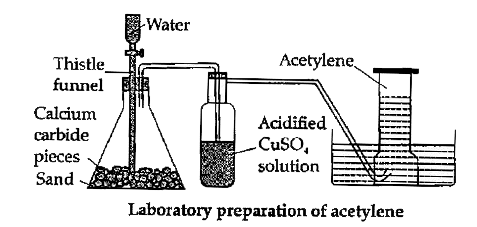Complete Solutions to SECTION-II of chapter SELF ASSESSMENT PAPER 1 of Class 10 book with complete answers and questions
| Class 10 | CHEMISTRY |
| Chapter | SELF ASSESSMENT PAPER 1 |
| OSWAL | SECTION-II |
| Number Of Questions | 49 |
| Academic Year | 2023-24 |
Write the equations for the formation of ammonia by the action of water on magnesium nitride
View SolutionHow is ammonia collected?
View SolutionWhy is ammonia gas not collected over water?
View SolutionWhich compound is normally used as a drying agent for ammonia?
View SolutionHow would you distinguish between `Zn^2+)andPb^(2+)` using ammonium hydroxide solution.
View SolutionM is a metal above hydrogen in the activity series and its oxide has the formula `M_(2)O`. This oxide when dissolved in water forms the corresponding hydroxide which is a good conductor of electricity. In the above context answer the following:
What kind of combination exists between M and O?
View SolutionM is a metal above hydrogen in the activity series and its oxide has the formula `M_(2)O`. This oxide when dissolved in water forms the corresponding hydroxide which is a good conductor of electricity. In the above context answer the following:
How many electrons are there in the outermost shell of M
View SolutionM is a metal above hydrogen in the activity series and its oxide has the formula `M_(2)O`. This oxide when dissolved in water forms the corresponding hydroxide which is a good conductor of electricity. In the above context answer the following:
Name the group to which M belongs.
View SolutionM is a metal above hydrogen in the activity series and its oxide has the formula `M_(2)O`. This oxide when dissolved in water forms the corresponding hydroxide which is a good conductor of electricity. In the above context answer the following:
State the reaction taking place at the cathode.
View SolutionM is a metal above hydrogen in the activity series and its oxide has the formula `M_(2)O`. This oxide when dissolved in water forms the corresponding hydroxide which is a good conductor of electricity. In the above context answer the following:
Name the product at the anode.
View SolutionRefer to the flow chart diagram below and give balanced equations with conditions, if any, for the following conversions A to D.

View SolutionGive one equation each to show the following properties of sulphuric acid:
Dehydrating property
View SolutionGive one equation each to show the following properties of sulphuric acid:
Acidic nature
View SolutionGive two balanced reactions of each type to show the following properties of sulphuric acid :
Non-volatile nature
View SolutionWhat would you observe in the following ?
Copper is heated with concentrated nitric acid in a hard glass test tube.
View SolutionWhat is the property of nitric acid which allows it to react with copper?
View SolutionA compound made up of two elements X and Y has an empirical formula X2Y. If the atomic weight of X is 10 and that of Y is 5 and the compound has a vapour density 25, find the molecular formula,
View SolutionState the inference drawn from the following observations :
On carrying out the flame test with a salt P, a brick red flame was obtained. What is the cation in P?
View SolutionState the inference drawn from the following observations:
A gas Q turns moist lead acetate paper silvery black. Identify the gas Q.
View SolutionState the inference drawn from the following observations:
pH of liquid R is 10. What kind of substance is R?
View SolutionState the inference drawn from the following observations:
Salt S is prepared by reacting sulphuric acid with zinc oxide.
View SolutionIdentify the anion present in each of the following compounds :
A salt M on treatment with concentrated sulphuric acid produces a gas which fumes in moist air and gives dense fumes with ammonia.
View SolutionMr. Ramu wants to electroplate his key chain with nickel to prevent rusting. For this electroplating:
Name the electrolyte
View SolutionMr. Ramu wants to electroplate his key chain with nickel to prevent rusting. For this electroplating:
Name the cathode
View SolutionMr. Ramu wants to electroplate his key chain with nickel to prevent rusting. For this electroplating:
Name the anode
View SolutionMr. Ramu wants to electroplate his key chain with nickel to prevent rusting. For this electroplating:
Give the reaction at the cathode
View SolutionMr. Ramu wants to electroplate his key chain with nickel to prevent rusting. For this electroplating:
Give the reaction at the anode.
View SolutionExplain the bonding in methane molecule using electron dot structure.
View SolutionCompare the compounds carbon tetrachloride and sodium chloride with regard to solubility in water and electrical conductivity.
View SolutionWhat is meant by a group in the periodic table?
View SolutionWithin a group where would you expect to find the element with
(A) the greatest metallic character?
(B) the largest atomic size?
View SolutionState whether the ionization potential decreases on going down a group.
View SolutionHow many elements are there in period 2?
View SolutionRewrite the following sentences by using the correct symbol `gt` (greater than) or `lt` (less than) in the blanks given :
The ionization potential of Potassium is ................. that of Sodium.
View SolutionThe electronegativity of iodine is ________that of chlorine. `(gt//lt )`
View SolutionGive reasons why?
Ionic compounds do not conduct electric current in the solid state
View SolutionGive reasons why?
Electrolysis is an example of a redox reaction.
View SolutionGive reasons why?
For the preparation of hydrochloric acid, hydrogen is not directly absorbed in water.
View SolutionGive reasons why?
Tap water is not used to prepare a solution of silver nitrate in the laboratory.
View Solution
Write the equation to explain the reaction taking place in the above diagram?
View Solution
Give the function of acidified copper sulphate solution.
View Solution
Give a reaction in which acetylene gas is prepared by synthesis reaction.
View Solution
(a) What is the reaction which a taking place ?
(b) Give the function of acidified copper sulphate solution.
(c) Give a reaction in which acetylene gas is prepared by synthesis reaction.
(d) Compare the reaction of acetylene with bromine water and liquid bromine.
(e) What happens when acetylene is heated in copper tube at `600^@C` ?
View Solution
What happens when acetylene is heated in copper tube at `600^(@)C`?
View SolutionDefine the term "Catenation”.
View SolutionConversion of ethene to ethane is an example of _______(hydration/hydrogenation) :
View SolutionThe catalyst used for conversion of ethene to ethane is commonly ______ (nickel/ iron/cobalt)
View SolutionThe product formed when ethene gas reacts with water in the presence of sulphuric acid is______ (ethanol/ethanal/ethanoic acid)
View Solution_______ burns with a non-luminous flame. (butane/methane/acetylene).
View Solution
SECTION-II questions and complete solutions for chapter SELF ASSESSMENT PAPER 1 of EVERGREEN CHEMISTRY (ENGLISH) of Class 10